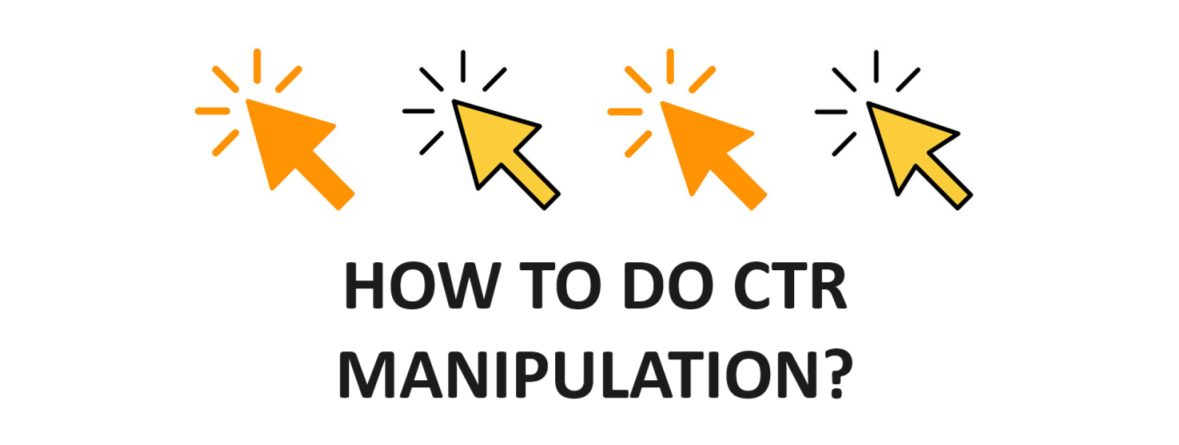CTR Manipulation Methods: Proven Approaches for Higher Interaction
CTR Manipulation Methods: Proven Approaches for Higher Interaction
Blog Article
Exploring the Partnership In Between CTR Manipulation Solutions and Customer Habits
In the world of digital marketing, the impact of click-through price (CTR) manipulation services on individual habits remains a facility and interesting topic. As on-line systems significantly rely on CTR metrics to measure the success of material, products, and solutions, understanding exactly how these manipulated prices influence individual interaction and decision-making processes is paramount. The interplay in between CTR manipulation and user behavior questions concerning credibility, reliability, and the moral effects of such practices. By exploring the detailed partnership between CTR manipulation solutions and user actions, interesting insights emerge that may reshape our understanding of electronic advertising techniques and their effects on consumers.
Impact of CTR Manipulation on Habits
Examining the influence of Click-Through Price (CTR) manipulation on customer behavior exposes essential understandings right into the characteristics of online involvement. CTR adjustment involves synthetically inflating the number of click a particular link or promotion to trick customers and search engines. This technique can result in an altered assumption of a website's popularity or significance, eventually affecting customer actions.

Additionally, CTR adjustment can skew the data used by formulas to personalize individual experiences. This can cause customers being offered content that does not straighten with their choices or rate of interests, ultimately leading to a decline in user fulfillment and interaction. Understanding the impact of CTR manipulation on user habits is important for preserving transparency and rely on on the internet interactions.
Individual Interaction With Controlled CTR
User engagement with manipulated CTR information commonly brings about manipulated perceptions of on-line web content popularity and significance. When users engage with content based upon synthetically filled with air Click-Through Rates (CTR), they may think that particular information, products, or services are a lot more popular or credible than they actually are. This can lead to individuals making choices based on deceptive information, causing potentially unfavorable outcomes.
Involvement metrics like sort, shares, remarks, and time spent on a page are usually influenced by CTR control. Individuals might be a lot more inclined to engage with content that appears to have higher engagement rates, further perpetuating the cycle of skewed assumptions. Therefore, content makers and advertisers may prioritize creating content that creates high CTR as opposed to focusing on producing truly useful and pertinent product.

Mental Effects of CTR Adjustment

Furthermore, the psychological effects of CTR control can likewise manifest in modified decision-making processes. Individuals might be extra inclined to click on web content entirely based upon its viewed appeal, as opposed to its real value or relevance to their requirements. This behavior shift can lead to a surface engagement with on the internet material, where users might forget high-grade but much less popular offerings in support of those with artificially enhanced CTRs.
Essentially, the emotional ramifications of CTR manipulation highlight the significance of keeping openness and authenticity in on the internet communications to foster authentic user interaction and count on.
Moral Considerations in CTR Control
CTR control raises worries regarding tricking customers, distorting information analytics, and compromising the trustworthiness of on the internet material. By artificially pumping up CTR, users might be misguided into clicking on web links or advertisements they would not have actually picked or else, leading to an insincere online experience.
One more ethical facet check that to consider is the fairness of adjusting CTR to acquire an unfair benefit over competitors. Engaging in such techniques not only breaches concepts of justice but additionally weakens the depend on that individuals put in online platforms. It is necessary for companies and electronic marketing experts to maintain moral standards in their techniques to make sure transparency, credibility, and lasting sustainability in the on the internet atmosphere.
Effects for Digital Advertising
CTR control can lead to skewed information analytics, misguiding marketing professionals into believing that their projects are performing better than they in fact are. When customers recognize that CTRs have been manipulated, it can wear down count on in the brand, leading to official source lasting adverse repercussions for consumer commitment and brand credibility.
Furthermore, using CTR adjustment services can produce an unfair affordable landscape, where companies that involve in such methods acquire an artificial advantage over those that adhere to moral advertising requirements. This can suppress development and creative thinking in electronic advertising and marketing, as success comes to be even more about manipulation tactics than providing real value to consumers. Ultimately, the implications of CTR manipulation for electronic marketing prolong past temporary gains, affecting the general sustainability and trustworthiness of advertising and marketing initiatives in the digital realm.
Final Thought
Finally, the connection between CTR control solutions and individual behavior is complex and diverse. The impact of CTR manipulation on behavior, user interaction with manipulated CTR, emotional impacts, ethical considerations, and implications for digital marketing all contribute in forming this partnership. Recognizing these dynamics is critical for marketers and researchers alike in order to navigate the honest effects and make best use of the performance of their electronic advertising and marketing approaches.
Report this page